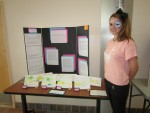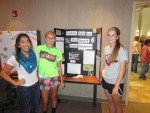The LTER Education and Outreach Committee’s holds monthly “First Wednesday” conference calls to maintain connections between site coordinators and stimulate discussions and ideas for site-specific activities aimed at moving the group closer to a holy grail of achievement--a cross-site educational initiative.
The recent, hour-long June conference call resulted in a viable three-prong approach that will further advance that goal. The call featured presentations on the successful Data Jam project initiated by Stephanie Bestelmeyer of the Jornada (JRN) LTER and her team. The basic idea behind the Data Jam is simple: give students real data sets, help them analyze what the data relays, and then allow them to create an innovative product that communicates the results for a nonscientist audience. Bestelmeyer and her team have organized JRN’s Desert Data Jam since 2012, and the data in each annual edition were sourced from the EcoTrends project (www.ecotrends.info). While Bestelmeyer and her team help with analysis, they encourage the students to interpret the findings in a unique, creative and non-traditional fashion. Projects are then judged by JRN scientists, community volunteers and educators and the winners awarded cash prizes during a ceremony at the New Mexico State University campus.
Winning projects from the last three years of the competition have included diverse ideas like a rap song interpreting cotton rat populations; a series of watercolor paintings representing solar radiation and soil temperature; a visualization and photo montage of a ballet dancer depicting desert precipitation;, and a children’s story and activity book explaining trends in rodent species’ populations.
Following the example of their JRN counterparts, Alan Berkowitz (BES) and his team initiated a Data Jam workshop at the summer institute for teachers in summer 2013, and held their first student Data Jam this spring. Berkowitz reported that while their project faced challenges inherent in a first-time endeavor, his team felt it was a worthwhile endeavor and will try it again next year, their confidence boosted by experience. With three years of experience under her belt, Bestelmeyer supported joint planning and implementation by sharing materials, lessons-learned and moral support.
During the call, the site Education representatives agreed that the EcoTrends data sets are a valuable resource that could provide a pathway to a cross-site project. The Data Jam project, complete with two successful site trials at JRN and BES, shows how it can be done.
The Data Jam is prong one of the three-pronged approach. The second is the newly established LTER Educational Digital Library (http://educationlibrary.lternet.edu), equipped with 10 LTER data-based lessons and another 20 currently in the review queue.
The third and final prong is a lesson plan developed by Bestelmeyer instructing teachers on how to conduct their own Data Jam using on-line EcoTrends data. The JRN team is also creating a Data Jam lesson that allows students to study and create an innovative product related to temperature and precipitation data from LTER sites located in several different ecosystems.
So we have a student-based, data-driven project using long term datasets, a lesson plan for teachers, and a tool to deliver not only the Data Jam lessons, but nearly a dozen others. The missing ingredients include adequate funding, network logistical support and, for the site representatives, time. Every representative acknowledges the potential in this triad, and with support from the LTER Network Office in the form of a dedicated network-level Education coordinator and funding for projects and annual meetings, we believe we can move forward and achieve success.

 Enlarge this image
Enlarge this image
